Louisiana is set to receive another $52 million to fund ongoing coastal restoration and construction work. The funds are being allocated from Clean Water Act fines paid by Transocean due to its liability in the 2010 BP Gulf Oil disaster. The money will go to pay for two projects ready to break ground, and for studies to lay the groundwork for hundreds of millions of dollars worth of large-scale coastal restoration efforts.
The projects include $8.7 million for filling old exploration canals near Jean Lafitte National Historical Park and $7.3 million for construction of a beach, dune and back marsh restoration project on West Grand Terre Island. The remaining $36.2 million will be used for planning and design of a number of projects including a freshwater diversion from the Mississippi River to the Maurepas Swamp, marsh restoration and ridge creation along Bayou Dularge and marsh restoration near the Lake Borgne Surge Barrier.
Should those projects be funded and come to fruition, they would entail hundreds of millions of coastal construction work. However, Justin Ehrenwerth, executive director of the Gulf Coast Ecosystem Restoration Council, said in an article in The Times-Picayune in mid-August that "the fact that the council has suggested they receive planning funds now does not guarantee the project will receive implementation funds in the future."
Louisiana's 2012 Master Plan identified $50 billion worth of construction projects over the next 50 years to provide 500-year flood protection for New Orleans, and to hopefully reduce Louisiana's problem of coastal erosion. The projects include a surge barrier at the mouth of Lake Pontchartrain near Slidell, shoreline protection, marsh and oyster reef recreation, ridge restoration, barrier island restoration and sediment diversions.
The current round of funding comes from the Restore Act's $800 million allocation of $1 billion in fines Transocean agreed to pay in a settlement in 2013. The state is expected to receive the funds in the Gulf Coast Restoration Trust Fund and initiate projects as money is available.
The state loses between 25 and 35 square miles of wetlands per year. At current land loss rates, another 640,000 acres, an area nearly the size of Rhode Island, will be underwater by 2050.


